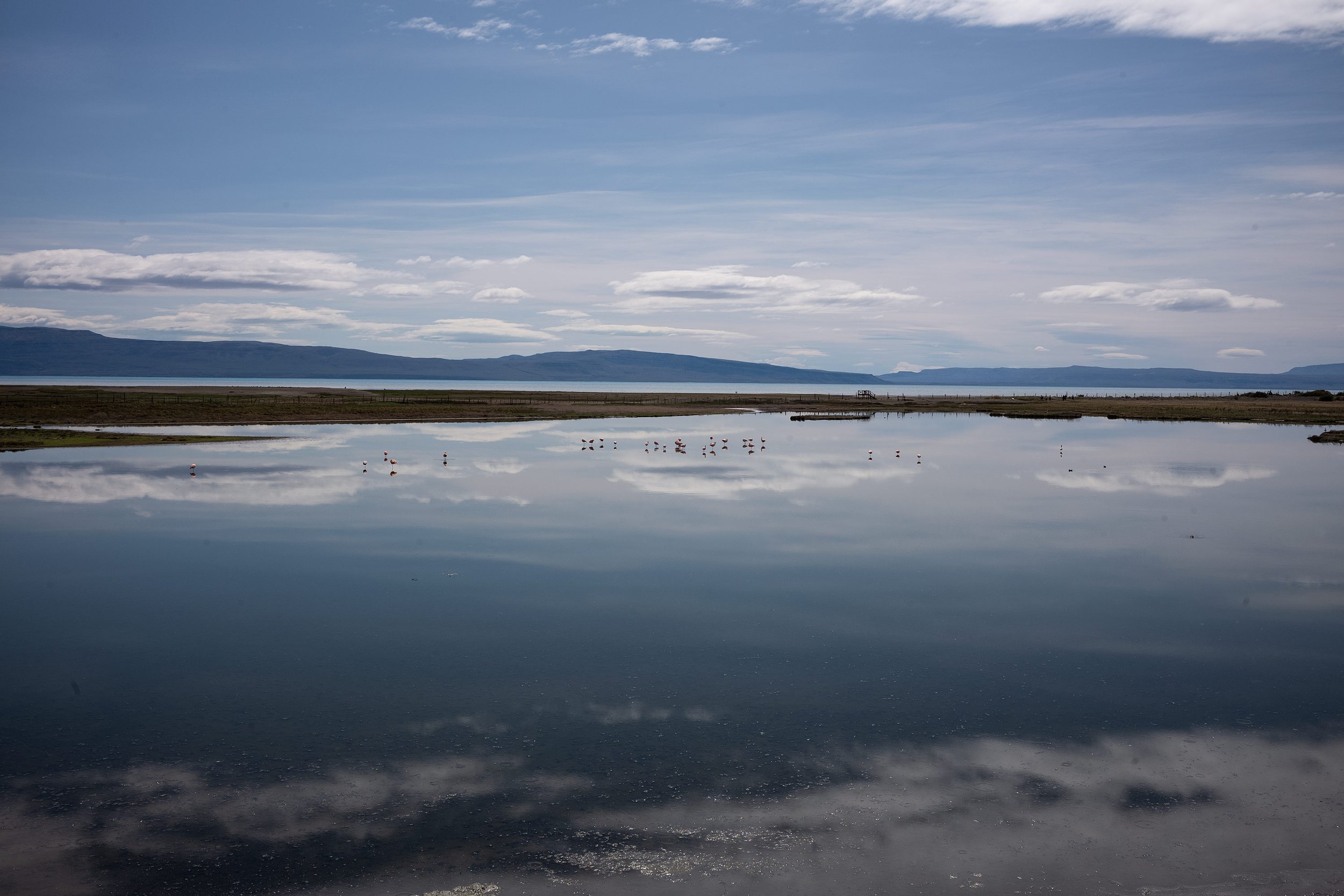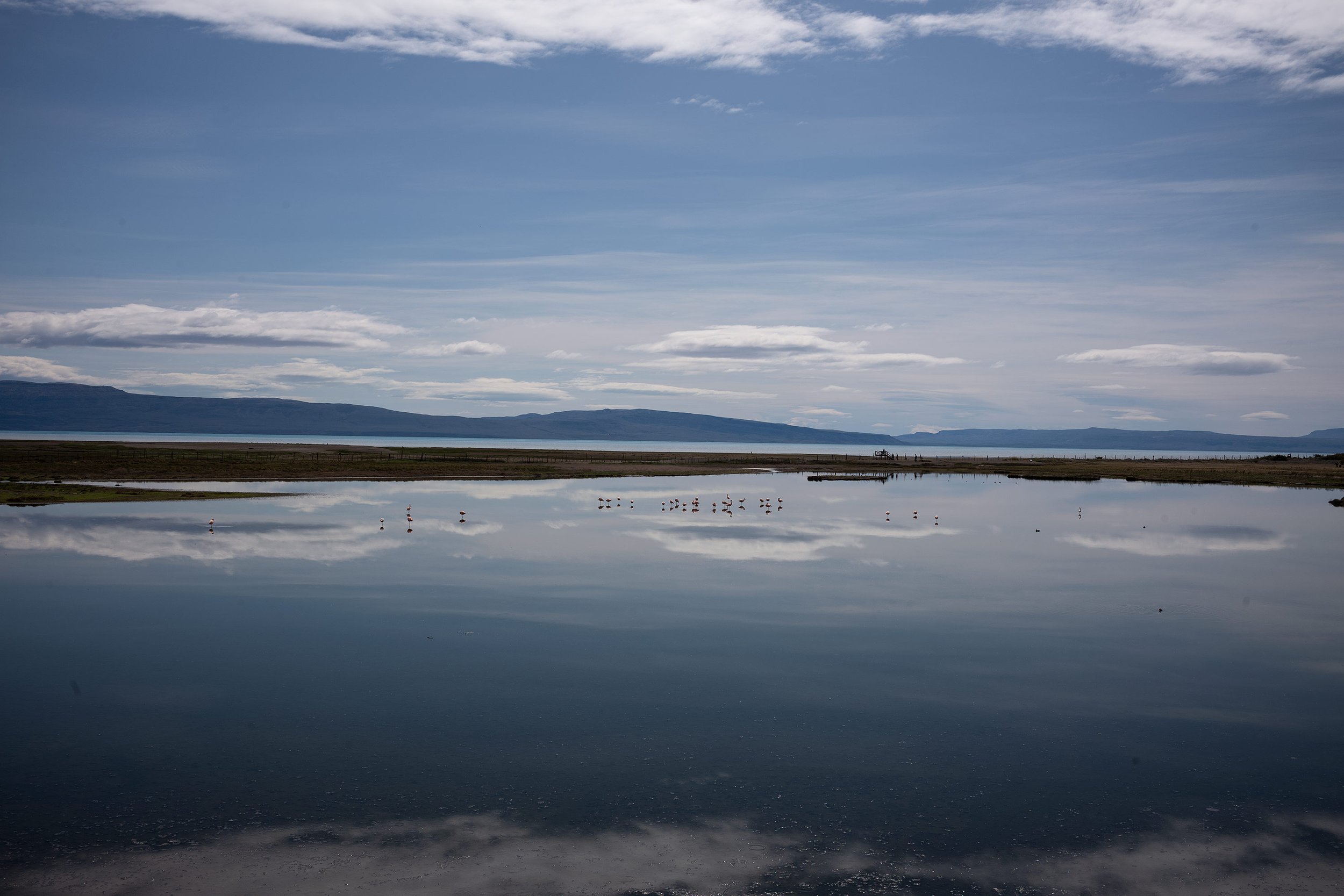
Patagonia: Chapter one
Arrival, El Calafate.
There’s an iceberg on the lake. I can see it from the window of my hotel. It sits on the water like a ship silhouetted against the mountains. It seems not to move, as if anchored to the bottom of the lake.
I flew on on the first flight out of Buenos Aires, landing in El Calfate at 10:30. Cecilia met me at the airport, holding a sign with my last name. Underneath she someone had written “Welcome!”. She asked me how my flght was and told me Pablo, our driver for the day, would be coming right around.
She asked me if I saw the mountains from the plane and I said no; I was on the other side. So you saw the river? she asked. Yes. She was excited for me, for having seen the turqoise colors and the way it wound through the landscape. She asked me to post photos to social media and raise awareness of the river. There’s a project being floated to dam the river and create a hydroelectric power plant, and she wants people to see the natural beauty, and what we would sacrifice.
Cecilia told me that the agenda for the day included a short hike around the Laguna Nimez and a visit to the Glacier Museum. She asked if I wanted to drop my things off at the hotel first and possibly get a snack. I asked if they had eaten and she told me that they had ben drinking maté all morning and were fine. She checked the weather and the wind conditions on her phone and said it might be better to do the hike first, as the day was sunny and the wind was low. I agreed. I like you, she said. You’re easy.
I’m on holiday, I said.

As we hiked, Cecilia pointed out the birds that flew around us, some seemingly unpreterbed by our presence. It was mating season and so we could see males and females in and around the tall grass, perched on bushes, nesting by the path. I asked her how she became a guide. She told me she was born in Patagonia, albiet further north and by the ocean, but she had been living in Calafate for a long time. She told me her grandparents first brought her to Calafate and when she first saw the Perito Moreno Glacier, she fell in love. She’s since traveled the world to visit glaciers, and is looking forward to visiting Glacier National Park in Montana, as there’s post-glacial landscapes there; something that you can’t see in Patagonia as it’s still in the throes of glacial activity.
In the distance we could see flamingoes, and we circumambulated the lagoon to reach a hide near where they collected. We climbed up to a perfect view of the birds, the lagoon, and a line of low mountains in the distance. The water was perfectly still and Cecilia commented that we had made the right choice in doing the hike first.
I asked her about the pandemic and how it affected the town. She, herself, was in Thailand when the pandemic first hit, scouting a potential tour. She managed to make it back to Argentina with her brother and found a cab that took them to his house, where she spent 4 months. Then, a friend who had a special dispensation to drive ships captains across Patagonia brought her to her mother’s house where she spent five more months. In total it was 11 months before she made it back home to Calafate.
She told me that she has multiple jobs, working as a doula and also selling women’s items in a shop at her house. She also educates teenage girls on feminine topics, but she does that for free.
During pandemia, she tells me that the government did pay guides, but guides were required to give lectures on zoom in return. She said it was a great exchange, and the lectures are now on various websites that promote the area.

They drop me off at the hotel to check in, but my room is not ready. The night before the hotel was full and it’s taking their staff the full amount of allotted time to turn the rooms. Check in isn’t until 15:00. It’s a quarter after one.
I put a bag in left luggage and order a snack in the bar. At 14:15, Cecilia and Pablo are already waiting for me in the lobby. We pile into the car and Pablo drives us to the glacier museum, which Ceclia tells me was designed to mimic an ice wall.
At the museum, she brings me to a large relief map of the ice pack, noting that after Antarctica and Greenland, it’s the third largest ice pack in the world. She explains the different types of glaciers and shows me where I’ll be going over the course of the next week and what I’ll see (weather permitting).
She’s most excited to show me the video of the arches of Perito Moreno collapsing. At certain times, the glacier will reach across the channel and touch the promontory on the other side of the lake. When that happens, two lakes are blocked from draining and build up pressure until they foce themselves under the ice pack, eventually creating a tunnel and arch beneath the ice. Then, as the water erodes and melts the glacier, the arch collapses slowly before it dramatically falls.
Cecilia’s been multiple times to try and see it fall. Once she was there for 2 days before she saw it; another time she watched for 3 days. The last time she attempted to see the event, no one saw it; the arch fell overnight. It’s unpredictable.
There were two films documenting two separate occasions, one shot as though it were a news broadcast, with reporters in the field and experts interviewed via “live” feed. The other presented the glacier in the first person, as a voiceover spoke with the voice of the glacier as it underwent the transformations and changes before its arch crashed finally into the lake.
Pablo and Cecilia leave me at the hotel. I ask if I’ll see her again and she says no. The agency had sent her my itinerary and her name wasn’t attached to any of the excursions. Tomorrow she has a group already and then she’s free for the following two days. She’s happy for the time off. Not that she wouldn’t take time for herself during the high season, anyway. She tells me she took a week to try and spot a rare bird that lives in lagoons at high altitude. It was three days to get to the lagoon and then two days of driving to various lagoons before they finally spotted it. She shows me video of their trip, driving in remote areas through harsh terrain. But it was worth it. One more sighting to add to her ever-growing list.

In the afternoon, I walk by the wetlands along the road back towards town. Cecilia had recommended the trout at La Zaina, and while I’ve paid for full board at the hotel, I’m excited to eat Patagonian trout. It turns out to be the best meal I’ll have in Patagonia. 🇦🇷












